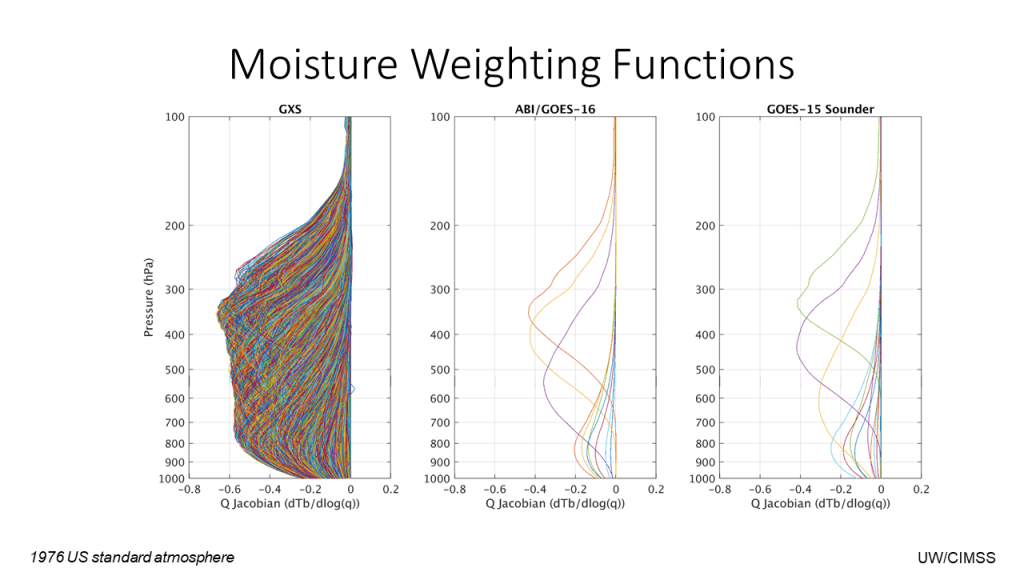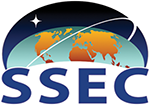History
“The present study [1971] shows that the infrared sounding from geostationary altitude is indeed feasible and the observing system simulation study…shows these observations to be very valuable.” (Possibilities for sounding the Atmosphere from a Geosynchronous Spacecraft (V. Suomi, T. Vondar Haar, R. Krauss, & A. Stamm)
“What about the future? These [VAS Demonstration: Description and Final Report] results are the foundation for future satellites. The VAS experience suggests that extension into the microwave region, and increased spectral resolution in the infrared region, are essential so that we can obtain soundings through persistent clouds and with improved vertical resolution. Geostationary microwave instruments and high spectral resolution infrared interferometers are feasible and would be highly useful.” (Forward by Verner E. Suomi, 1985)
Even years before the launch on of GOES-I (8), there was a call to replace the low spectral resolution sounder with a high spectral resolution instrument. (First on GOES-I, then on GOES-K (10), neither update happened.) More on the GOES-8/15 GOES Sounders, which were used operationally, but limited by the lack of vertical resolutions (pdf and pptx).
The 1999 ORD (Operational Requirements Document) issued by NWS already pointed out “Consequently, the temporal requirement for hourly data must be met by geostationary, rather than polar orbiting satellites, and the accuracy/vertical resolution requirements must be met by a sounder with high spectral resolution.”
Smith Sr., W. L., Revercomb, H., Bingham, G., Larar, A., Huang, H., Zhou, D., Li, J., Liu, X., and Kireev, S.: Technical Note: Evolution, current capabilities, and future advance in satellite nadir viewing ultra-spectral IR sounding of the lower atmosphere, Atmos. Chem. Phys., 9, 5563–5574, https://doi.org/10.5194/acp-9-5563-2009, 2009.
NWS Position Regarding a Sounder on GOES-R Series (circa 2010): the requirements for atmospheric temperature and water vapor profiles, as stated in the Consolidated Observing user Requirements List (CORL), are still valid. Improvements in temperature and moisture soundings and other products from a geostationary platform could play a large part in meeting those requirements and enhancing the NWS capability to address the societal impacts of weather. As pointed by one HWT forecaster in 2018 report, “Assessing the vertical distribution of moisture in the environment can really help one determine the vertical structure later in the day as mixing commences.” Compared to broadband imagers and sounders, observing absorption lines is needed to meet requirements for temperature and moisture structure (or the radiances) to improve short-term weather forecasting by resolving vertical changes. Extensive studies have shown the value of polar-orbiting hyperspectral soundings in operational forecasting, and regional and global models. We expect that geostationary hyperspectral soundings will build on that success and take advantage of the increase in temporal refresh.
Geosynchronous Imaging Fourier Transform Spectrometer (GIFTS) was built by NASA, but didn’t get a needed ride to geo, which was to be supported by the Navy. “In 2006, predominantly because of budgetary pressure, the HES was removed from the GOES-R/S series.”
WMO’s implementation plan for evolution of space and surface-based sub-systems of the GOS 2005 (WMO/TD No. 1267): GEO Sounders – All meteorological geostationary satellites should be equipped with hyper-spectral infrared sensors for frequent temperature/humidity sounding as well as tracer wind profiling with adequately high resolution (horizontal, vertical and time).
This paper (Towards an Operational NOAA GEO Hyperspectral Infrared Sounder), presented by Elsayed R. Talaat, Louis W, Uccellini, and Stephen M. Volz at 2019 Joint Satellite Conference, describes technologically mature options available to fly an operational hyperspectral IR sounder over the U.S. on a geostationary satellite in the near-term, as well as the business case for doing so.
Sieglaff, Justin M.; Schmit, Timothy J.; Menzel, W. Paul and Ackerman, Steven A. Inferring convective weather characteristics with geostationary high spectral resolution IR window measurements: A look into the future. Journal of Atmospheric and Oceanic Technology, Volume 26, Issue 8, 2009, pp.1527-1541. (link)
F. Iturbide-Sanchez et al., “Exploration of a Future NOAA Infrared Sounder in Geostationary Earth Orbit,” in IEEE Journal of Selected Topics in Applied Earth Observations and Remote Sensing vol. 15, pp. 1543-1561, 2022, doi: 10.1109/JSTARS.2022.3142069.
Exploring the spectral information (and degrees of freedom) between the shortwave, midwave and longwave bands:
W. L. Smith et al., “Hyperspectral Satellite Radiance Atmospheric Profile Information Content and Its Dependence on Spectrometer Technology,” in IEEE Journal of Selected Topics in Applied Earth Observations and Remote Sensing, vol. 14, pp. 4720-4736, 2021, doi: 10.1109/JSTARS.2021.3073482. (link)
Eyre, J.R., Bell, W., Cotton, J., English, S.J., Forsythe, M., Healy, S.B., et al. (2022) Assimilation of satellite data in numerical weather prediction. Part II: Recent years. Q J R Meteorol Soc, 521– 556. https://doi.org/10.1002/qj.4228
High Spectral Resolution IR Bibliography from 1965 – 2016.

